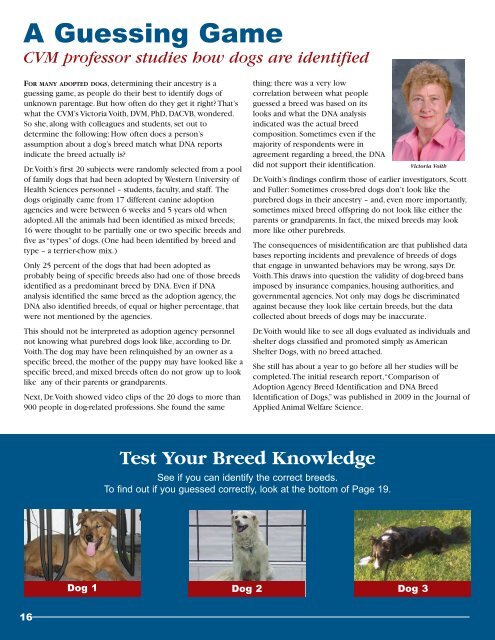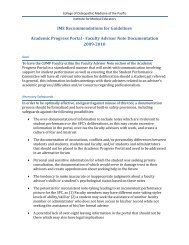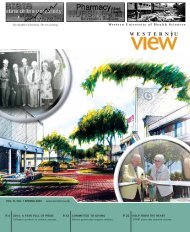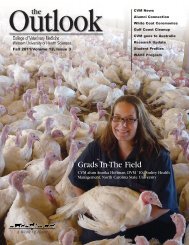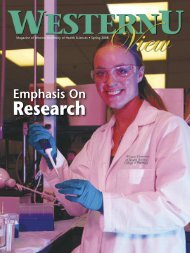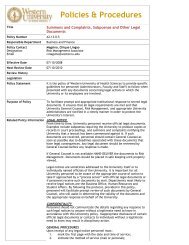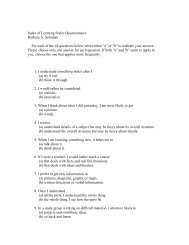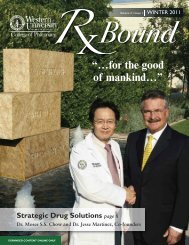Preceptor Profile - Western University of Health Sciences
Preceptor Profile - Western University of Health Sciences
Preceptor Profile - Western University of Health Sciences
- No tags were found...
You also want an ePaper? Increase the reach of your titles
YUMPU automatically turns print PDFs into web optimized ePapers that Google loves.
A Guessing GameCVM pr<strong>of</strong>essor studies how dogs are identifiedFOR MANY ADOPTED DOGS, determining their ancestry is aguessing game, as people do their best to identify dogs <strong>of</strong>unknown parentage. But how <strong>of</strong>ten do they get it right? That’swhat the CVM’s Victoria Voith, DVM, PhD, DACVB, wondered.So she, along with colleagues and students, set out todetermine the following: How <strong>of</strong>ten does a person’sassumption about a dog’s breed match what DNA reportsindicate the breed actually is?Dr. Voith’s first 20 subjects were randomly selected from a pool<strong>of</strong> family dogs that had been adopted by <strong>Western</strong> <strong>University</strong> <strong>of</strong><strong>Health</strong> <strong>Sciences</strong> personnel – students, faculty, and staff. Thedogs originally came from 17 different canine adoptionagencies and were between 6 weeks and 5 years old whenadopted. All the animals had been identified as mixed breeds;16 were thought to be partially one or two specific breeds andfive as “types” <strong>of</strong> dogs. (One had been identified by breed andtype – a terrier-chow mix.)Only 25 percent <strong>of</strong> the dogs that had been adopted asprobably being <strong>of</strong> specific breeds also had one <strong>of</strong> those breedsidentified as a predominant breed by DNA. Even if DNAanalysis identified the same breed as the adoption agency, theDNA also identified breeds, <strong>of</strong> equal or higher percentage, thatwere not mentioned by the agencies.This should not be interpreted as adoption agency personnelnot knowing what purebred dogs look like, according to Dr.Voith. The dog may have been relinquished by an owner as aspecific breed, the mother <strong>of</strong> the puppy may have looked like aspecific breed, and mixed breeds <strong>of</strong>ten do not grow up to looklike any <strong>of</strong> their parents or grandparents.Next, Dr. Voith showed video clips <strong>of</strong> the 20 dogs to more than900 people in dog-related pr<strong>of</strong>essions. She found the samething: there was a very lowcorrelation between what peopleguessed a breed was based on itslooks and what the DNA analysisindicated was the actual breedcomposition. Sometimes even if themajority <strong>of</strong> respondents were inagreement regarding a breed, the DNAdid not support their identification.Victoria VoithDr. Voith’s findings confirm those <strong>of</strong> earlier investigators, Scottand Fuller: Sometimes cross-bred dogs don’t look like thepurebred dogs in their ancestry – and, even more importantly,sometimes mixed breed <strong>of</strong>fspring do not look like either theparents or grandparents. In fact, the mixed breeds may lookmore like other purebreds.The consequences <strong>of</strong> misidentification are that published databases reporting incidents and prevalence <strong>of</strong> breeds <strong>of</strong> dogsthat engage in unwanted behaviors may be wrong, says Dr.Voith. This draws into question the validity <strong>of</strong> dog-breed bansimposed by insurance companies, housing authorities, andgovernmental agencies. Not only may dogs be discriminatedagainst because they look like certain breeds, but the datacollected about breeds <strong>of</strong> dogs may be inaccurate.Dr. Voith would like to see all dogs evaluated as individuals andshelter dogs classified and promoted simply as AmericanShelter Dogs, with no breed attached.She still has about a year to go before all her studies will becompleted. The initial research report, “Comparison <strong>of</strong>Adoption Agency Breed Identification and DNA BreedIdentification <strong>of</strong> Dogs,” was published in 2009 in the Journal <strong>of</strong>Applied Animal Welfare Science.Test Your Breed KnowledgeSee if you can identify the correct breeds.To find out if you guessed correctly, look at the bottom <strong>of</strong> Page 19.Dog 1 Dog 2 Dog 316


